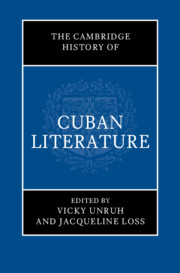Book contents
- The Cambridge History of Cuban Literature
- The Cambridge History of Cuban Literature
- Copyright page
- Dedication
- Contents
- Figures
- Contributors
- Acknowledgments
- Introduction Unfinished Histories
- Part I Literature in the Early Colony
- Part II Cuban Literature’s Long Nineteenth Century
- 3 Alexander von Humboldt and the Cultural Invention of Cuba Among Its Nineteenth-Century Intellectual Elite
- 4 Philosophy and Pedagogy in Félix Varela, José de la Luz y Caballero, and Enrique José Varona
- 5 Mercedes Merlin and the Rhetoric of Life Writing, Exile, and Race
- 6 The Lyric Vernacular of Cuban Romanticism
- 7 Gertrudis Gómez de Avellaneda as Literary Precursor and Transatlantic Intellectual
- 8 Racialized Futures
- 9 Journalism and Nineteenth-Century Literary Culture
- 10 José Martí as Hemispheric Visionary
- 11 Julián del Casal and the Other Faces of Cuban Modernismo
- 12 Performance Worlds of Nineteenth-Century Cuban Theater
- Part III Literary and Intellectual Culture in the Twentieth-Century Republic
- Part IV The Revolution’s Literary-Cultural Initiatives and Their Early Discontents
- Part V Cuba and Its Diasporas into the New Millennium
- Epilogue
- Select Bibliography
- Index
- References
10 - José Martí as Hemispheric Visionary
from Part II - Cuban Literature’s Long Nineteenth Century
Published online by Cambridge University Press: 31 August 2024
- The Cambridge History of Cuban Literature
- The Cambridge History of Cuban Literature
- Copyright page
- Dedication
- Contents
- Figures
- Contributors
- Acknowledgments
- Introduction Unfinished Histories
- Part I Literature in the Early Colony
- Part II Cuban Literature’s Long Nineteenth Century
- 3 Alexander von Humboldt and the Cultural Invention of Cuba Among Its Nineteenth-Century Intellectual Elite
- 4 Philosophy and Pedagogy in Félix Varela, José de la Luz y Caballero, and Enrique José Varona
- 5 Mercedes Merlin and the Rhetoric of Life Writing, Exile, and Race
- 6 The Lyric Vernacular of Cuban Romanticism
- 7 Gertrudis Gómez de Avellaneda as Literary Precursor and Transatlantic Intellectual
- 8 Racialized Futures
- 9 Journalism and Nineteenth-Century Literary Culture
- 10 José Martí as Hemispheric Visionary
- 11 Julián del Casal and the Other Faces of Cuban Modernismo
- 12 Performance Worlds of Nineteenth-Century Cuban Theater
- Part III Literary and Intellectual Culture in the Twentieth-Century Republic
- Part IV The Revolution’s Literary-Cultural Initiatives and Their Early Discontents
- Part V Cuba and Its Diasporas into the New Millennium
- Epilogue
- Select Bibliography
- Index
- References
Summary
This chapter examines Cuba’s most renowned nineteenth-century writer, José Martí, also known as the precursory founding figure of the transformative poetic movement Spanish American modernismo and an essayist, fiction writer, playwright, orator, political activist, and national hero. Connecting sequential key moments of Martí’s personal, intellectual, and political biography with his writing, ideas, and emergent social and political consciousness, the chapter considers Martí as a hemispheric figure whose work intertwines Cuba, Latin America, and the US. The chapter focuses particularly on Martí’s extensive body of journalistic crónicas, the majority of which were written outside Cuba, demonstrating his adept use of the genre’s stylistic and thematic malleability for multiple social and political effects and in the creation of his social philosophy and a hemispheric imaginary.
Keywords
- Type
- Chapter
- Information
- The Cambridge History of Cuban Literature , pp. 169 - 184Publisher: Cambridge University PressPrint publication year: 2024

